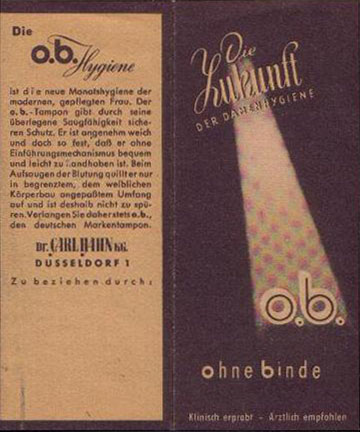See a Modess True
or False? ad in The American Girl
magazine, January 1947, and actress Carol Lynley in
"How Shall I Tell My Daughter" booklet ad
(1955) - Modess . . .
. because ads (many dates).


|

What does o.b. mean?
Part 1 (Part 2)
Folder for o.b. tampons, Germany, probably
early 1950s.
When I opened the museum in my
house (see some pictures),
in 1994, I
called the library of the
Johnson & Johnson company,
which owned o.b., to ask what
o.b. meant. No one knew.
The lady said she would ask
old-timers with the company to see
if they remembered - if they were
in on it in the first place.
I knew that a German company,
Dr. Carl Hahn GmbH, invented the
tampon in the late 1940s or early
1950s and owned the tampon until
the 1970s, when J&J took over.
(A company ad said the o.b.
"designer" was Judith
Esser.) I also knew German
pretty well, having long ago
diddled around in graduate school
studying for a master's in German
(I fled to Germany before getting
it and stayed 13 memorable years
in Heidelberg, Frankfurt and
Aschaffenburg; everyone should
flee to someplace far away at
least once - look at this
landscape to see why).
So - hmm, lessee - it's a tampon,
meaning no pad. Could it be ohne Binde,
which means "without [a] pad"?
("Binde" looks as if it would mean
"belt," so, "without [a] belt," -
which would make sense - but belt
is in fact "G�rtel," like our
English girdle, and pad is
"Binde.") German nouns - Binde -
are capitalized; marketing people,
even in Germany, play with words
and made the B small.
In 2000 an e-mailer to this site
(here)
insisted it stood for obstetrician
- but I thought a woman needing an
obstetrician would rather use a
pad, not a tampon. And that's an
English word. And why did periods
- periods! - sit after the o and
b? Anyway, she was wrong, as
you'll see.
I called the library lady back
and offered my guess, which she
took under consideration. But, as
you can see on the folder below, I
was right. So
I had the huge pleasure of
telling J&J what one of
their product names meant!
Like the name o.b., early
American tampons often printed the
words pad or napkin on their boxes
so women could make a connection
to something familiar - see Sa-tips,
for example.
O.b. is the first commercial
tampon indigenous to Europe that I
know of; the American company
Tampax advertised in Europe in the
late 1930s (here)
but probably gave up until after
the war. I've heard of German
women sewing their tampons around
1900, I assume part of a long
tradition of women making their
own tampons.
Like almost all early tampons in
the U.S.A. (for example, Fibs) o.b.
had no applicator, which Tampax invented
and patented. Lox
("the
theatrical tampon," not
because of its histrionics but
because the company was trading on
the use of tampons by people who
must be on a stage) did have a
single tube (Tampax employed two)
and exemplified a reason why
tampons came into general use: they loxed
tampons in place - sorry,
locked - so they wouldn't fall off
as pads could - and of course were
invisible compared to the enormous
pads of the time (here from
a slightly earlier era, the middle
1920s).
A Dutchman kindly sent me the
scans.
|
|

|
The contributor
didn't mention what size the
folder is.
Originally the beam of light
trained on o.b. did not have the
red-and-yellow pattern; that's a
moire pattern caused by the dots
in the picture meeting the pixels
of our image.
The left side
reads (my translation)
The o.b. hygiene is the new
monthly hygiene of the modern
woman who takes good care of
herself. The o.b. tampon gives
certain protection through its
superior absorption ability. It's
pleasantly soft yet firm enough to
make insertion comfortable and
easy. It swells with blood in a
limited way that conforms to the
female body, and which a woman
can't detect. Therefore always ask
for o.b., the German brand tampon.
Dr. Carl Hahn KG
Dusseldorf 1
Buy at
The right side:
The future
of women's hygiene
o.b.
ohne binde [without {a} pad]
clinically tested
recommended by doctors
|
|

|
The text reads:
It will thrill
every woman . . . .
The age-old problem of invisible
monthly protection is solved!
Small tampons formed from cotton
that are used internally and which
are easy to remove with a built-in
string absorb the bleeding
internally.
This most modern
monthly hygiene has proved itself
for more than a decade in the West
and is preferred by millions of
women. The advantages of the
discarding of pad and belt [Binde
und G�rtel] are so convincing that
it is clear that:
1. No hindrance
during "your days":
A tampon, which is worn
internally, can't rub or hinder
you while walking.
2. Not visible
under clothing: A tampon worn
internally is invisible. You can
move about unembarrassed in a
close-fitting dress, in a sport
dress and even in a bathing suit.
3. No odor: Because
tampons completely absorb the
blood internally there's no chance
of embarrassing odor.
4. No
embarrassment: You can carry
several of the small tampons in a
hand bag any time, which protects
you from an unpleasant surprise.
The German brand
o.b. combines all these
advantages. The new o.b. takes all
unpleasantness from the period.
Young girls are
advised to ask their doctor before
using o.b.
|
Next:
Part 2 What does o.b. mean?
�2006 Harry Finley. It is illegal to
reproduce or distribute any of the work on
this Web site
in any manner or medium without written
permission of the author. Please report
suspected
violations to [email protected]
|